Undiscovered by American tourists, the small city of Beja offers great wine, unique pastries and an incredible history.
A Short History
Early Homo heidelbergensis were in present-day Portugal 400,000 years ago and humans arrived in what is now Portugal around 40,000 years ago. At least 2,500 years ago, Celtici tribes and later the Lusitanians ruled the area in the centuries before the Romans conquered the Iberian Peninsula.
In 48 BCE, Julius Caesar named the town Pax Julia (Peaceful Julius), later Pax Augustus. The Visigoths defeated Rome and ruled starting in the 6th century only to be defeated themselves by the Umayyad (North African) army in 713. Battles between the Moors and Christian armies went back and forth for hundreds of years between 910 and 1234, when the Christians finally retook Beja for good. By then, the city had been reduced to rubble and pretty much abandoned.
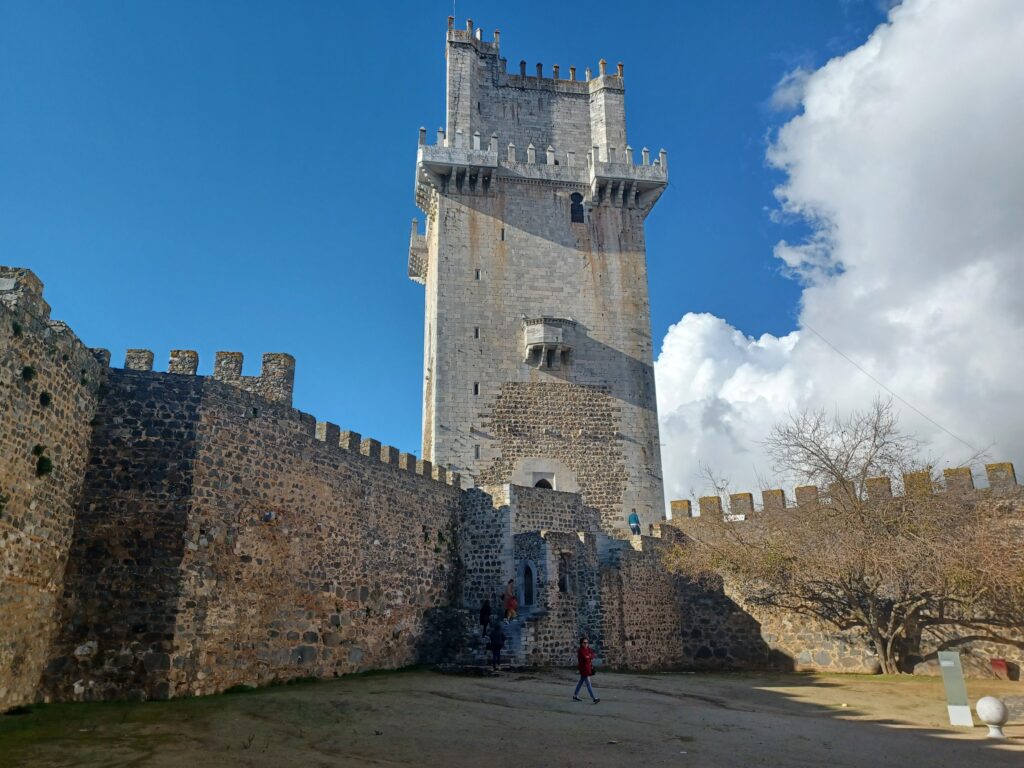
In the 13th century the Beja Castle was built, but it wasn’t until the 16th century that the city was once again granted city status.
Foodie Beja
The food of the Alentejo region is hearty with an emphasis to pork.
Stews, soups, and main dishes are sure to be seasoned with lots of garlic, bay leaf, coriander, mint, and, of course olive oil. Alentejo is, after all, a huge olive producing region.

Vegetarian Beja
Reality check, it’s not easy to eat vegan or vegetarian in Beja. The city is small and there’s limited choices.
And, to make it even more difficult, many dishes you might assume are vegetarian have sneaky ingredients. For example, some traditional pastelarias might use lard in their dough, rather than butter. This is a leftover from the times when pig fat was much cheaper and more readily available than butter. Be sure to ask before ordering.
Dona Tengarrinha is a rarity in Beja, a vegan restaurant. They rotate a delicious variety of dishes like a vegan quiche, meatless loaf, and warming soups. Prices are very reasonable, too. Even if you’re not veg., you’ll like Dona Tengarrinha.
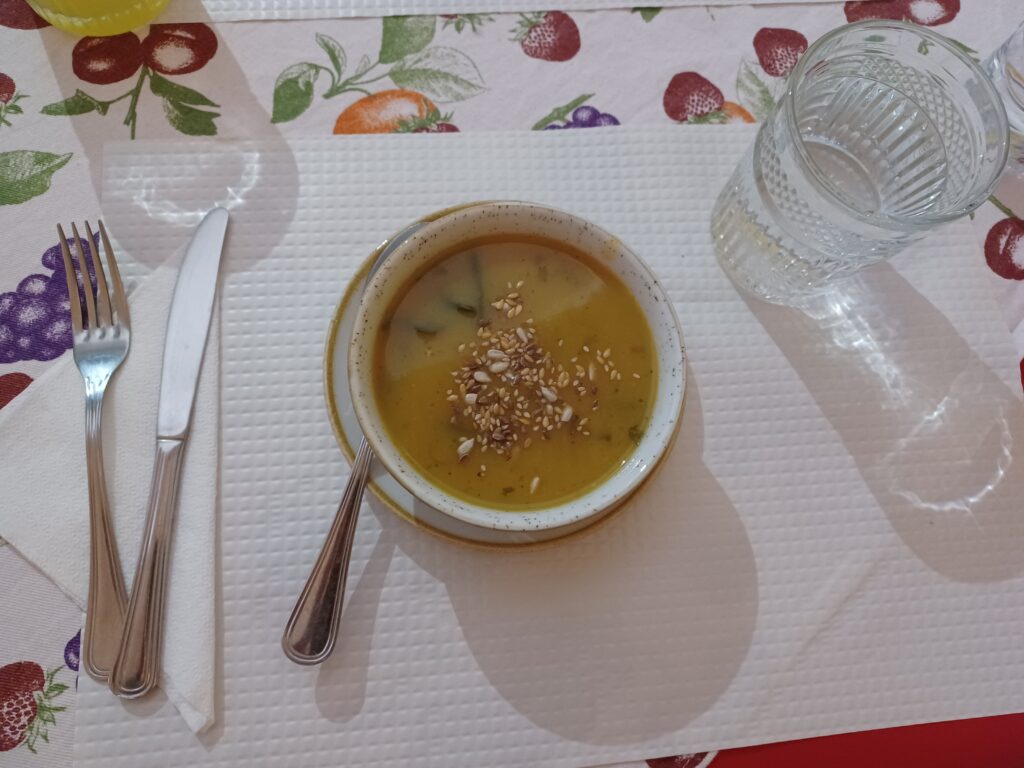
Sabores do Campo is a vegetarian buffet. Pay by weight.
Quejo Serpa
Serpa is a small city 30 minutes from Beja surrounded by farmland. Sheep from the area produce a much sought-after milk that is turning in the local cheese, Quejo Serpa.
The cheese is made from raw sheep’s milk and is semi-soft, depending on how long it is aged. Like Quejo Azeitao, the Quejo Serpa uses a plant-based coagulant, rather than rennet made from the lining of a cow’s stomach. In this case, the coagulant is made from the thistle of the wild artichoke.
Many restaurants in Beja offer cheese plates featuring Quejo Serpa. If you want to bring some cheese back with you to your home country, be sure to check the regulations for raw milk cheese.
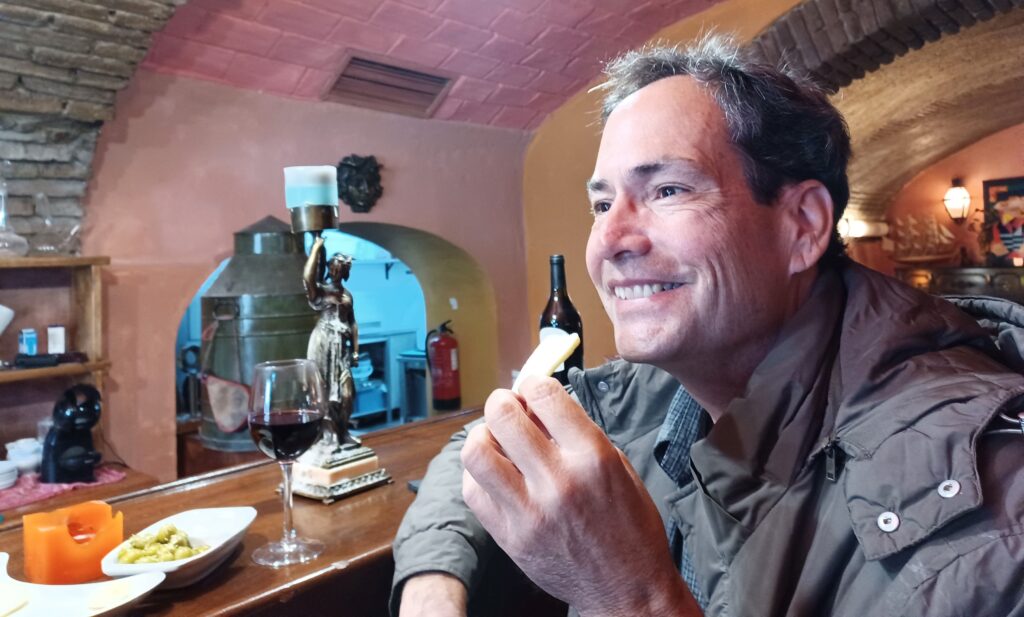
Pastry
Beja is a small city, but it has several excellent spots to get a sweet treats. Many of the options fall under the category of Convent Sweets which originated in nearby churches, made by religious orders to raise money.
The granddaddy of Beja Pastelarias is Luiz da Rocha. They’ve been cranking out sweets at a very high level for over 130 years!
Downstairs is the cafe serving delicious pastries like the Figo (Fig). Surprisingly, there’s no figs in this little chocolate cookie/cake. It gets it’s name from from it’s shape, which looks like a little fig. But, Luiz da Rocha is best known for the Porca de Beja (see below).
There’s also a popular restaurant upstairs.
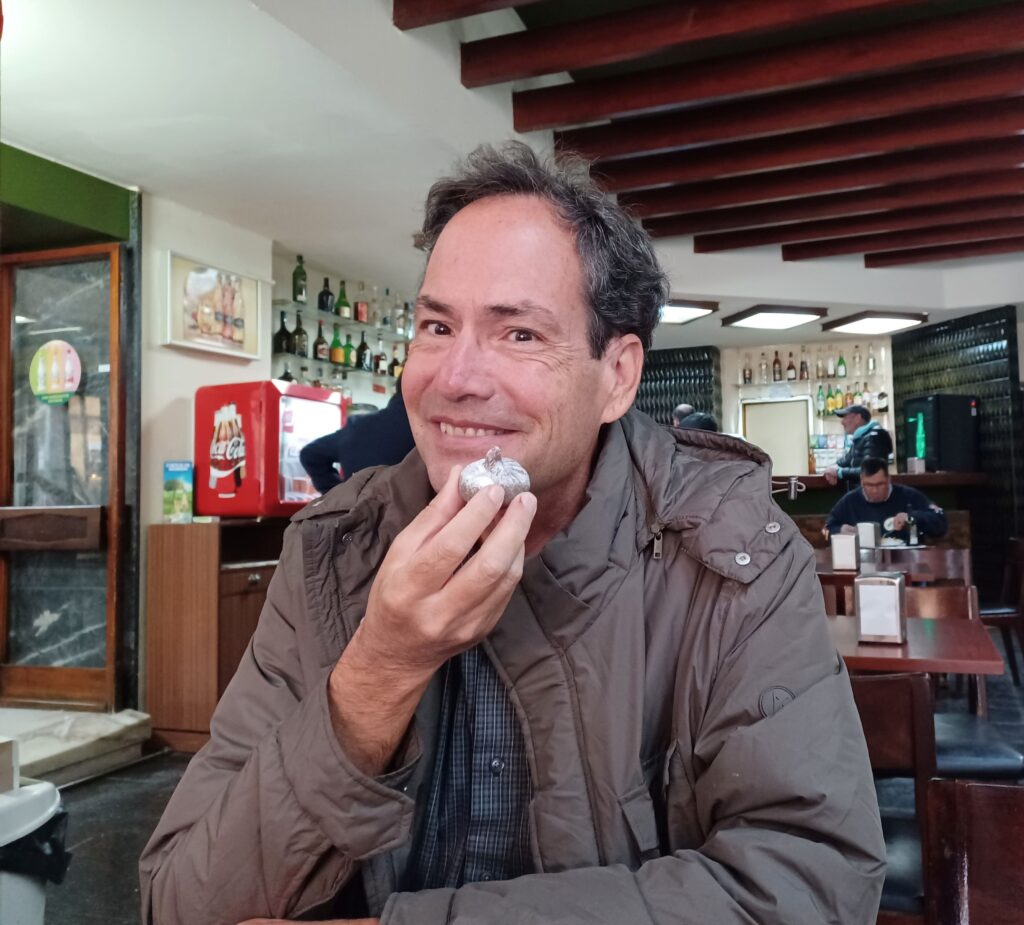
Another great spot is Casa de Cha, which translates to Tea House. In such a coffee-centric culture, it’s nice to have a place with an extensive tea list. They also specialize in Convent Sweets. One of my favorites is their Tosquiadas (see below), which is a perfect accompaniment to a cup of tea.

Perhaps the most characteristic bakery in Beja, and certainly one of my favorites, is Pastelaria Bambina. Locals hang here enjoying a coffee (that may have a shot of liquor in it) and delicious pastries. The owner prides himself on offering treats that no one else has.
The namesake Bambina is a moist cake made with almond paste, covered in slivered almonds, and powdered sugar. Delicious.
If you want something more decadent, there’s the Bambina Mariana. It’s the same as the Bambina with a dollop of sweet egg custard on top. Divine!
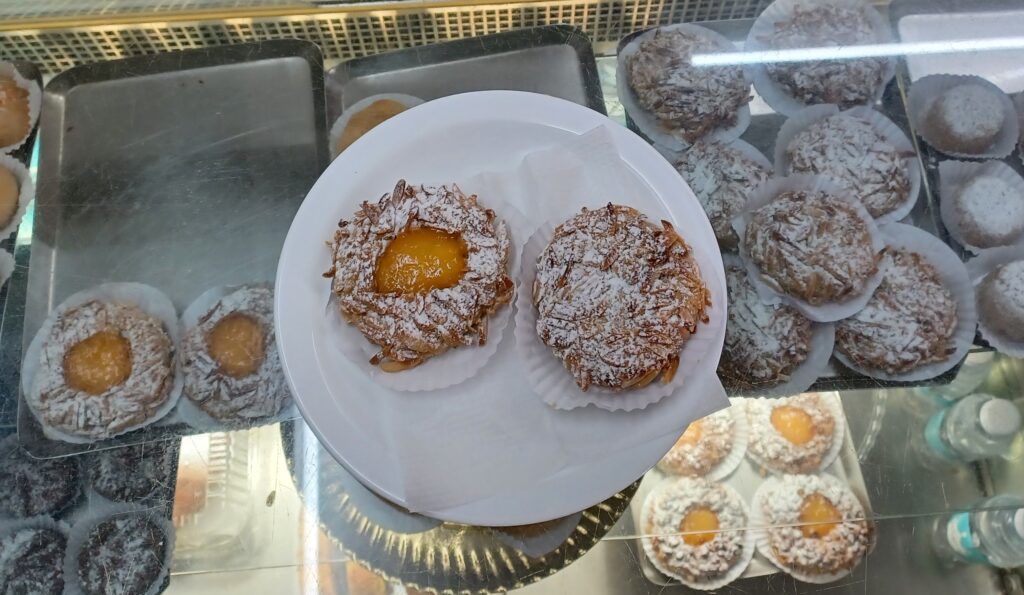
Porcinho Doce (Porca de Beja)
If there’s one sweet associated with Beja, it’s the Porcinho Doce, or Sweet Pig. This cake pays homage to the famous black pigs of Alentejo whose flesh is used in many traditional dishes. No pigs, however, are harmed in this delicious cake. Shaped like a pig and covered in chocolate frosting with “Beja” piped on the side in vanilla frosting, the Porca de Beja is filled with sweet egg custard or egg threads. Often, the pig depicted is a mother with her piglets suckling her.
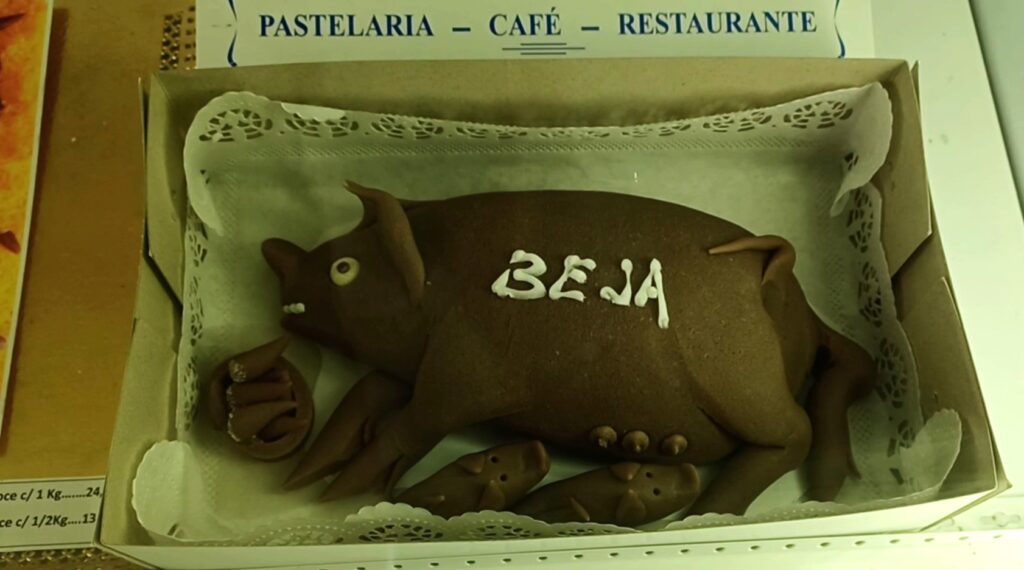
The cake itself isn’t huge, but you’ll probably need a couple friends to finish one off. The best are at Luiz da Rocha.
Azevia
Another Convent Sweet, Azevia originated in nearby Évora at the Convent of Santa Clara. The crust is traditionally made with flour and lard, so vegetarians should be sure to ask.
The crust is cut into a circle and filled with sweet chic peas or sweet potato, folded over and deep fried. Then, the Azevia is topped with sugar. If chic peas or sweet potato doesn’t sound like a suitable filling for a sweet pastry, you’ll have to trust me, it’s very, very good.
In Beja, Casa de Cha makes a variation on the Azevia by baking the dough rather than frying it. Yum.
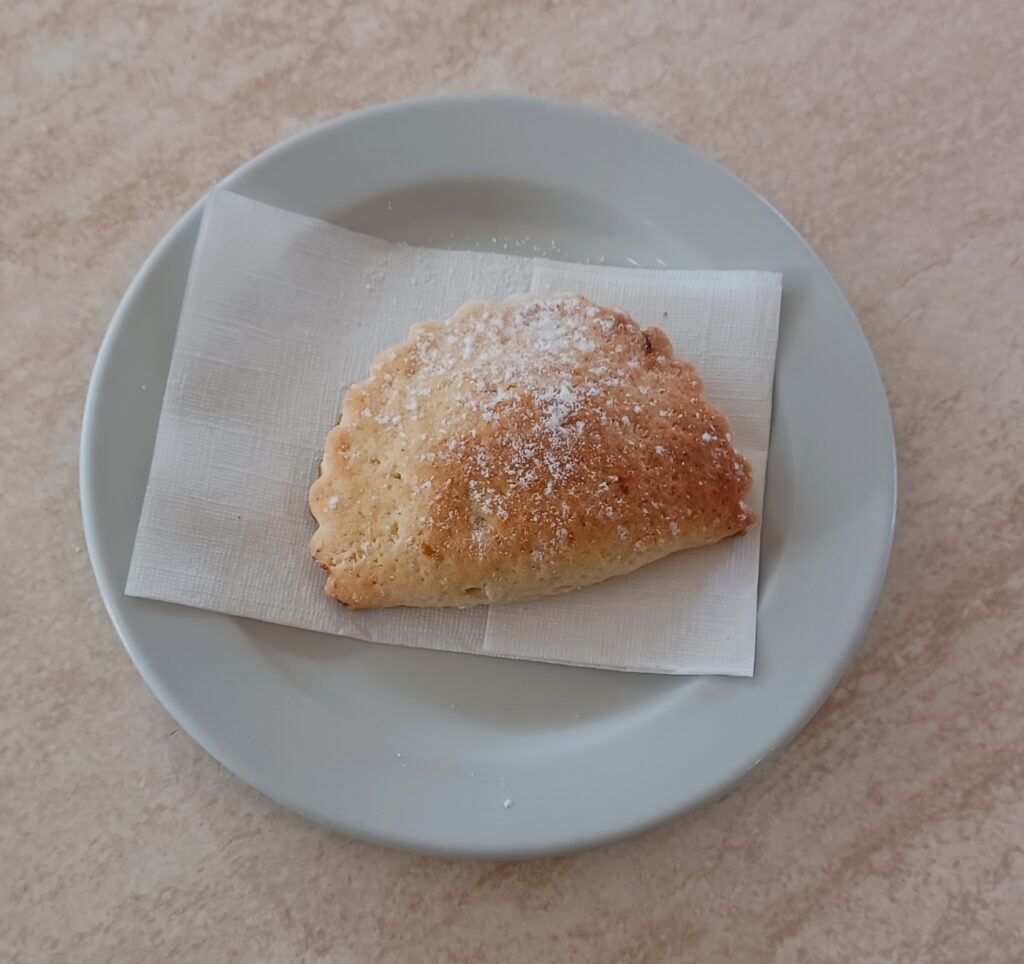
Tosquiada
These little Convent Sweets are so simple, yet amazingly delicious. Made from egg whites, almonds, and sugar, these cookies bake up nice and crisp. Perfect for dunking in a cup of coffee (or tea). My favorite spot for a Tosquiada in Beja is at Casa de Cha.
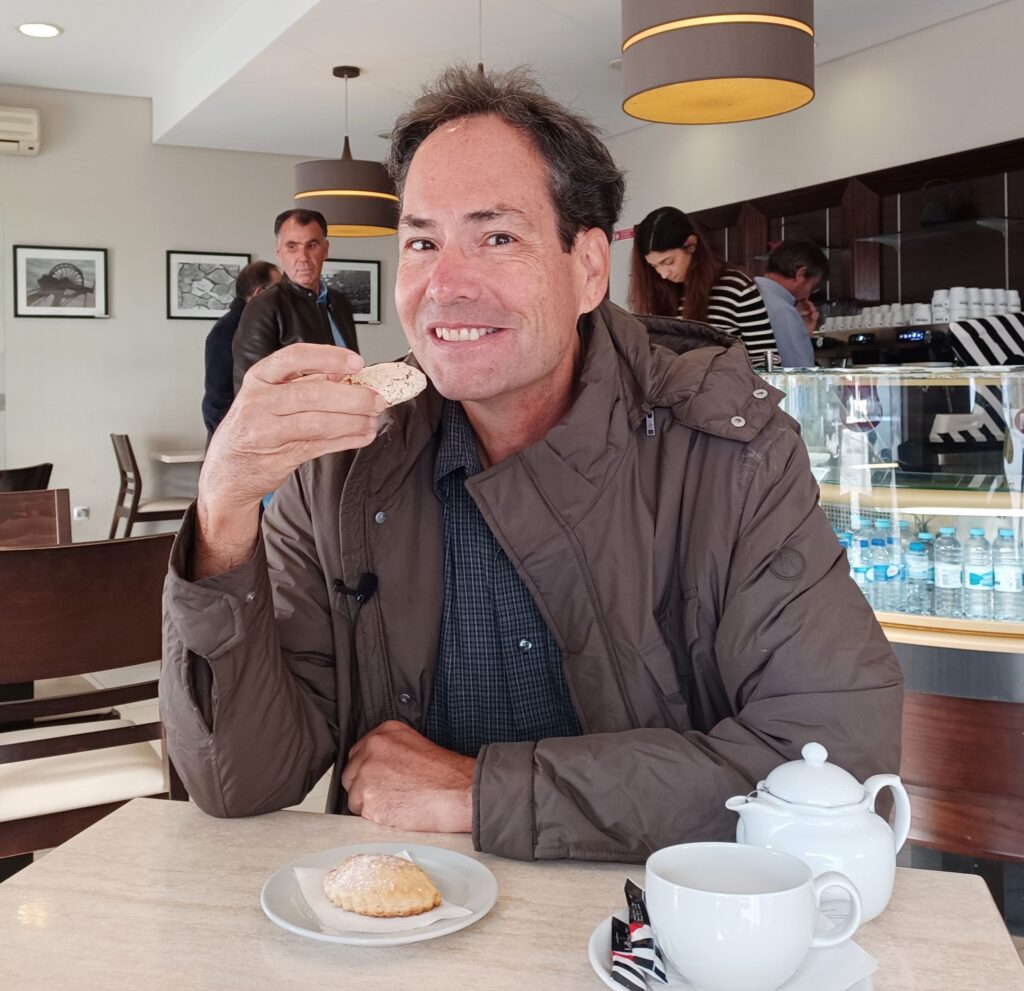
Market
The municipal market in Beja closed a few years ago for remodeling. Even though it was supposed to reopen in 2023, that hasn’t happened and looking through the locked doors, it doesn’t appear it will reopen anytime soon.
However, right across the street from the historic Church of Santo Amaro is an outdoor market. There is no mention of it on the Internet or Google Maps. But, it’s pretty big for a city the size of Beja, taking up 2 blocks with all kinds of produce and meat vendors. There’s even a guy selling lovely local ceramics.
Like almost all European markets, some vendors are reselling produce from the rest of Portugal or the EU, but many are farmers selling whatever their farm is producing from the back of their truck. Quite charming.
It appears the market is only open on Saturday morning, but if you’re in Beja on that day, be sure to seek it out. Drop me a note if you have any more information about this market.
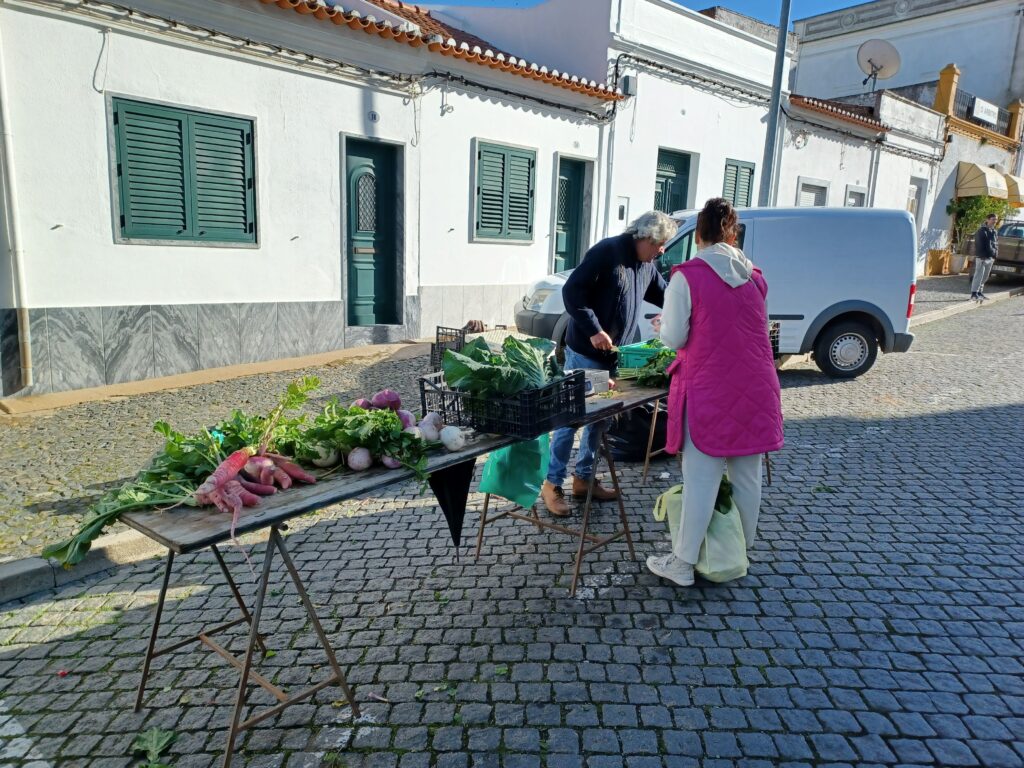
Drinking in Beja
Alentejo (the region where Beja is located) is one of the top wine producers in Portugal. Only Duoro (where Port is made) and Lisbon produce more.
Beja lies in the Évora subregion which is characterized by long hot summers and rainy winters. Red wines are hearty and full-bodied with Aragonez (called Tempranillo in its native Spain) and Castelão, a grape that is often used for blending but can be harsh and tannic when young.
I’m always surprised when I visit a wine region in Portugal and have difficulty finding a good wine bar where I can sample different varietals from several vintages. But, in much of Portugal, that’s the way it is, so I guess I should stop be surprised.
Of course most restaurants have Alentejo wine on the menu and you can always get a glass of wine at a cafe or pastelaria (bakery). But, I’m looking for a place to taste and sample. Oh well.
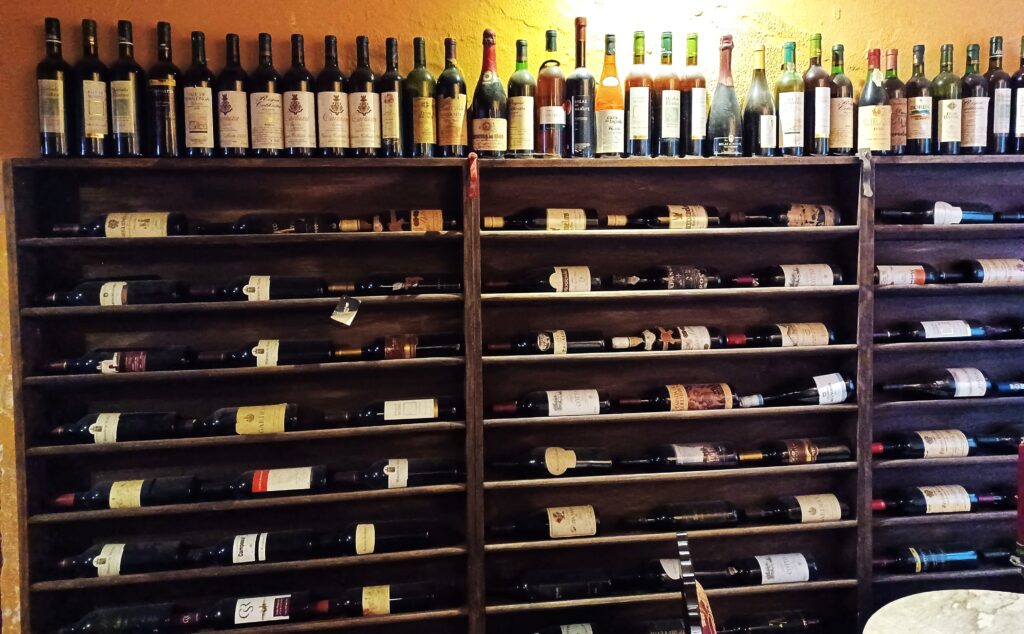
That said, there’s a great spot in Beja called Os Infantes. Housed in a cool 16th century (or maybe earlier) stone building with gorgeous arches, Os Infantes is, ostensibly, a restaurant. But, it’s the ambiance that puts this place over the top.
The owner is an artist and his paintings, surely inspired by Picasso, adorn the walls as well as the label of the house wine. We like to sit at the bar and nurse a glass of house wine and chat with the bartender. They also have a nice wine cellar, so you can buy a bottle of an older vintage as well.

Wineries
If you have wheels, there are some nice wineries you can visit.
Herdade dos Grous
This winery and 5 star hotel is about 25 minutes from Beja by car. The property is spectacular with a restaurant and wine tastings daily.
Herdade da Mingorra
Just a few minutes from Herdade dos Grous is Herdade da Mingorra, one of the oldest vineyards in the area. Their reds use international varietals like Cab Sauv, Merlot, and Syrah, but they also use Portuguese grapes like Aragonez, Castelão, and Trincadeira.
Herdade do Vau
This winery features their acclaimed RISO Reserva Red. The wine undergoes an extended maceration period and 16 months of aging in French oak. Schedule a tasting in advance.
Things to do in Beja
There are some can’t miss sites in Beja. You could probably do them in a single day, but if you stay a little longer, you’ll find the charms of Beja get under your skin.
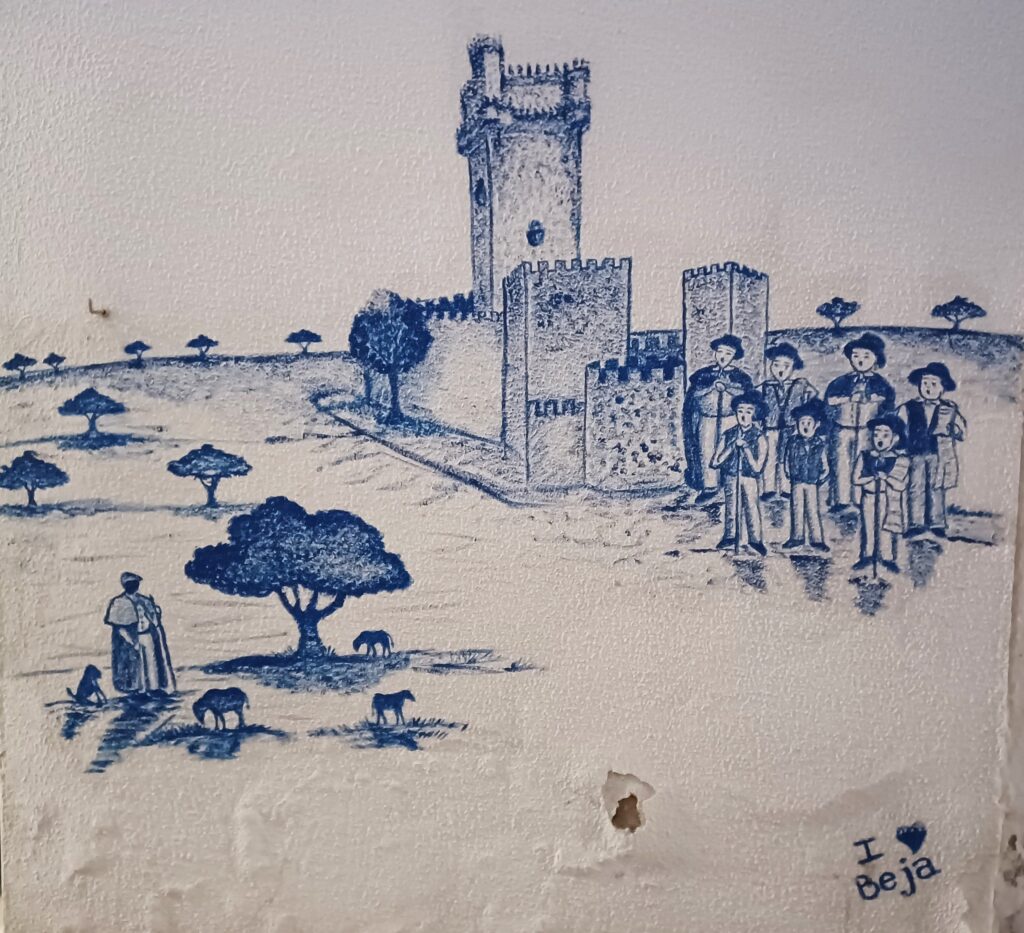
Beja Castle
Beja sits on top of a hill so it’s an ideal strategic point. That’s why Celtic tribes, the Romans, the Visigoths, and the Moors wanted it.

In the 13th century, when the Moors were pushed out after hundreds of years of back and forth, the Beja Castle was built. Spending a couple of Euros to climb the tower and see the surrounding land gives you an idea as to why they chose this site. Perfect site lines all the way around made sure no one would sneak up on you. This was surely a location that was used by armies dating back to at least Roman times.
One fascinating aspect of the castle to look for is the markings on the stones. Masons would mark each stone with a distinctive “signature” showing that they had worked on that stone. This was how they got paid. Count up the stones with your unique marking on it, multiply by the rate per stone and count the money!

Walking around the courtyard of the castle and strolling the walls, it’s fun to imagine what life would’ve been like here in the 13th century. However, just because this castle looks to be in good condition (especially when compared to some others in Portugal and Europe), it wasn’t always this way. A massive restoration project began in 1938 and continued for decades. It including reconstructing walls and gates as well as maintenance to keep the castle structurally sound. The tower was even closed for a period after a balcony collapsed.
Jorge Vieira
Jorge Vieira was a sculptor born in 1922 in Lisbon. His surreal work is on display in a museum on the grounds of the Beja Castle. The museum is small, so there is limited space for his work. But, the staff rotates what is on display monthly. During our visit an aroused pig sculpture was the centerpiece of the exhibition. Several drawings by Jorge were also on the walls.
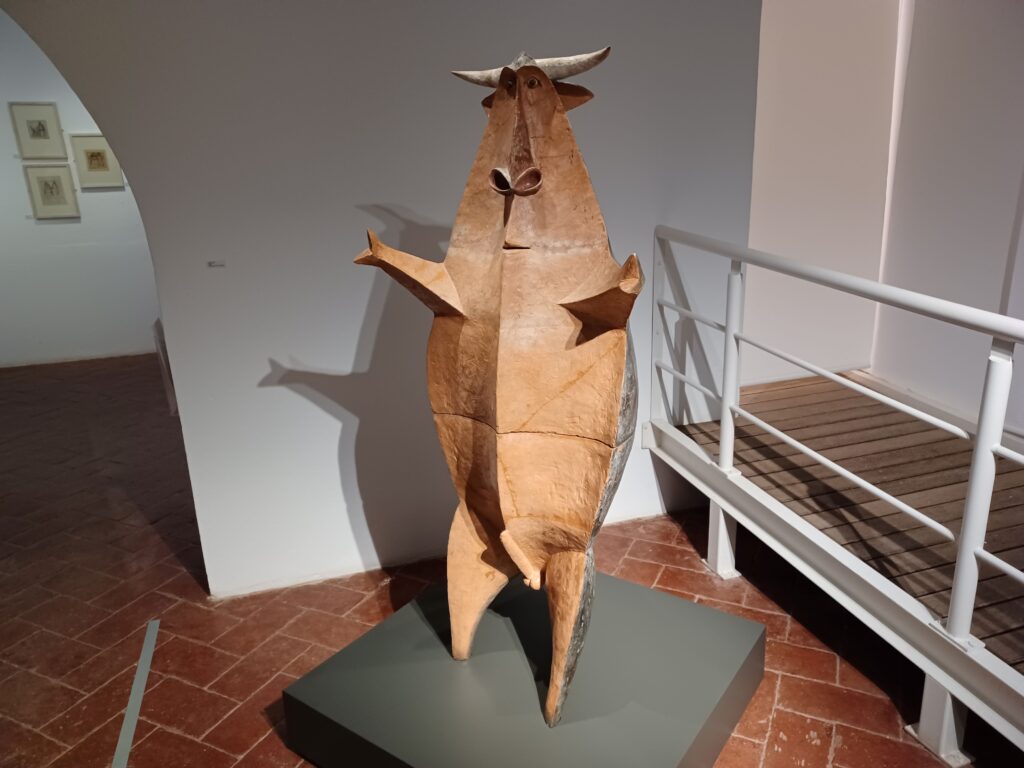
Jorge was also a highly political artist. He began his professional life under the fascist dictatorship of Salazar’s Estado Novo (new state). Of course, fascists don’t particularly care for provocative art, so Vieira had to display some of his work elsewhere.
One of his greatest works, the Monument to the Unknown Political Prisoner, is an indictment of the Salazar regime. It was first displayed in London in 1952.
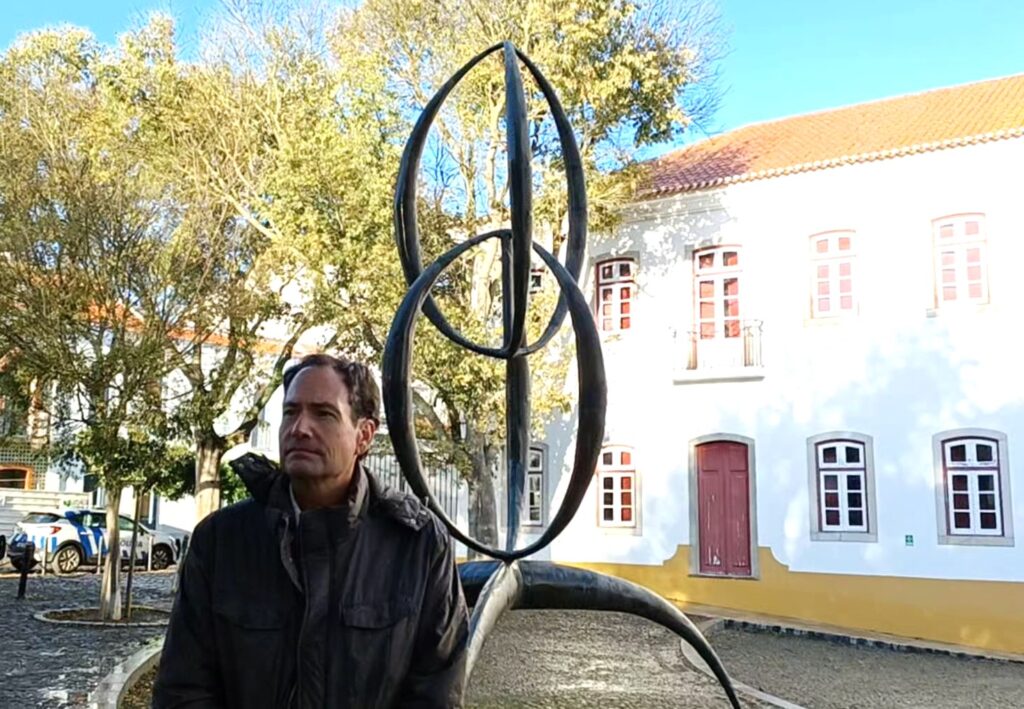
Jorge lived in nearby Évora and loved to visit Beja for the relative calm in the city. He told the city that if they could find a public place to display the Monument to the Unknown Political Prisoner, he would give it to them. Luckily a great spot was found and the work is now outside the Pousada De São Francisco.
Another sculpture, Memorial a Jorge Vieira, is on a roundabout near the edge of town.
Beja Cathedral
Igreja Paroquial de São Tiago, aka the Beja Cathedral, is next to the castle. The church was built in 1590 on the site of an older church. It’s worth a look inside for the gorgeous Azulejo murals.

Other Churches
In the 1800’s, Portugal underwent a reformation that closed the convents and monasteries. This was ultimately unsuccessful as the government wanted to convert the churches to schools or sell to private ownership. Very few Portuguese could afford the price or even the upkeep of these buildings, so they sat vacant and crumbling. Eventually, many went back to being churches while others were used as libraries and government buildings. The old Santo Antonio church, for example is now a social security office.
On the other hand, the Capela de Nossa Senhora da Piedade (Chapel of Our Lady of Mercy) sat vacant for decades, maybe centuries, after its owner locked it up and walked away. Fortunately, a local man would regularly open up the chapel to keep it from falling into complete ruin.
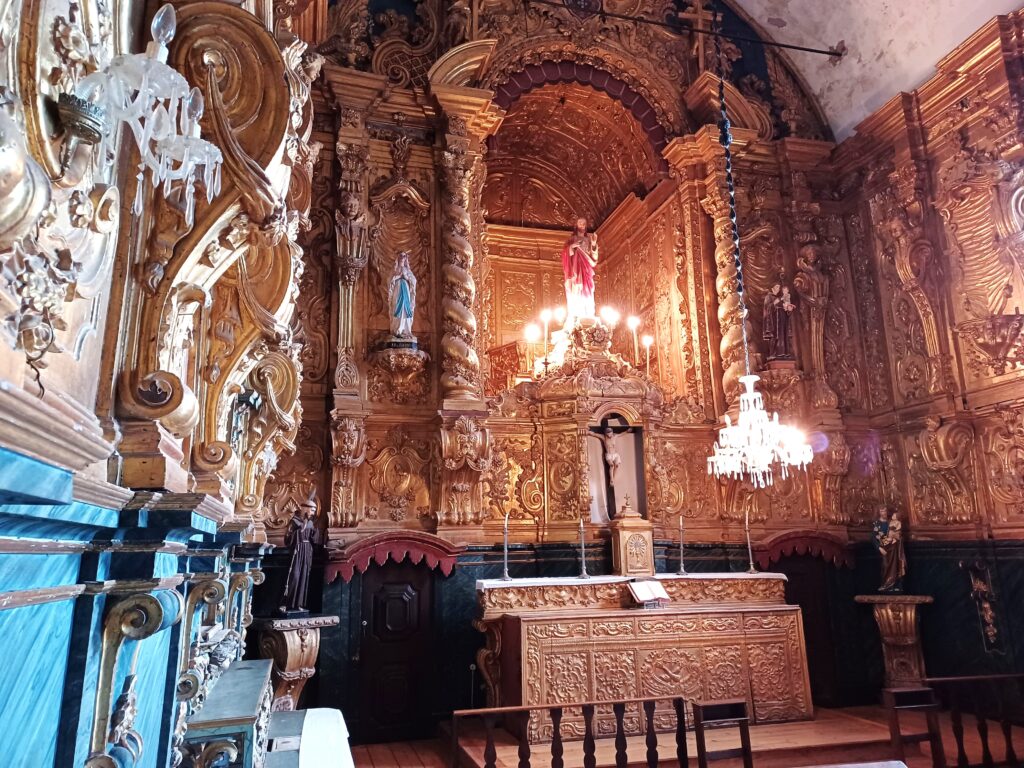
Today, you can walk inside the little 15th century chapel and see the intricate woodwork painted gold. Behind an alter is a hidden entrance to where older frescoes are painted on the walls. This area isn’t open to visitors, but the Docent may remove the panel and let you look inside. It is hoped that funds will become available and permission will be granted for a full restoration of this long-forgotten place.

Roman Museum
During a construction project in the 1980’s, these Roman ruins were discovered. This small museum, Nucleo Museologico, the the fruit of the archeological work and excavation done in subsequent years.
You’re issued plastic booties to place over your shoes and walk on glass above the site. Plus, there’s lot of ceramics and pieces of mosaics in display cases.

Visigoth Museum
The Visigoths, a Germanic tribe often called barbarians, ruled this part of Portugal for hundreds of years between the fall of Rome and the Umayyad invasion in the 8th century. But, you’ll hear little of this time when people talk about the history of Portugal.
In Beja, however, there’s the largest collection of Visigoth era artifacts in Portugal. Inside the 16th century Church of Santo Amaro, there is artwork and architectural elements like columns and arches dating back over 1,000 years.
Grape vines are common theme, meaning that the Visigoths were probably winemakers. And, how can you call someone who makes wine a barbarian?

Train Station
Many train train stations in Portugal have works of art displayed in the form of Azulejo murals. These painted tiles come in both geometric patterns and depictions of images.
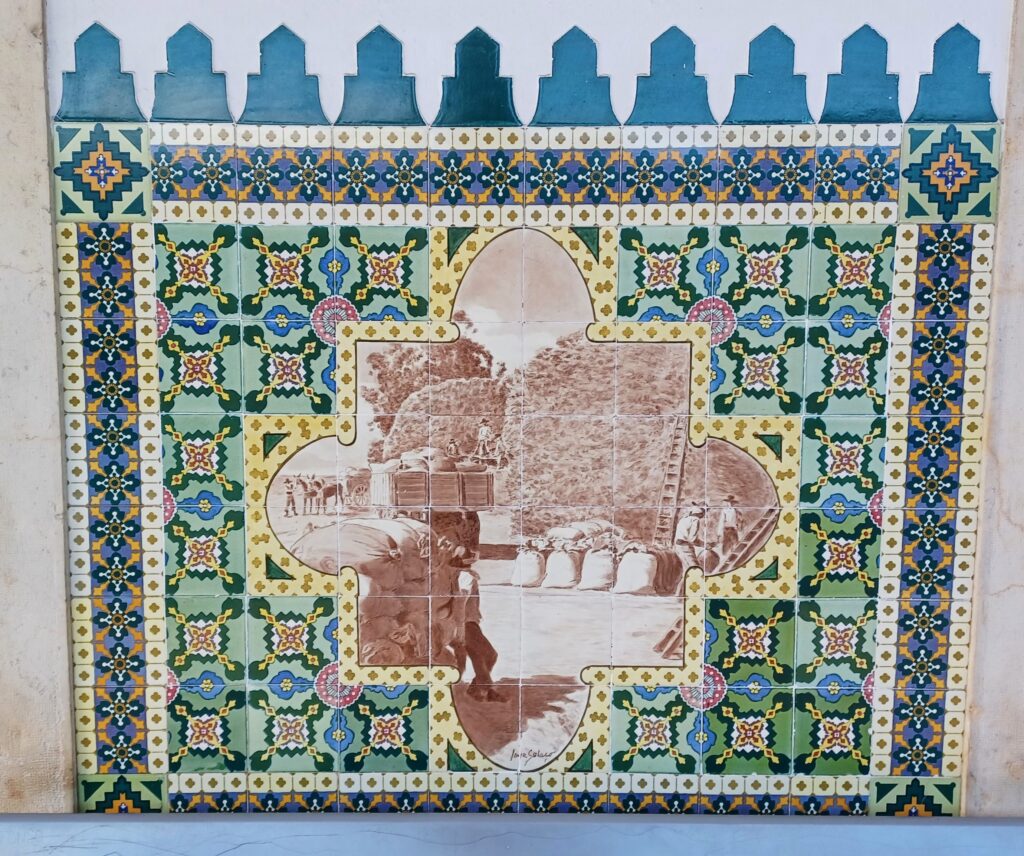
The most famous train station Azulejo works are in Porto at the Sao Bento train station. But, the tiny, often empty, Beja train station has some nice examples of Azulejo murals as well. There are religious motifs and famous landmarks represented in tile, but my favorite are the scenes of everyday life in Beja and the surrounding rural areas. Harvesting grain, herding sheep, and cork trees are some of the evocative images at the station.
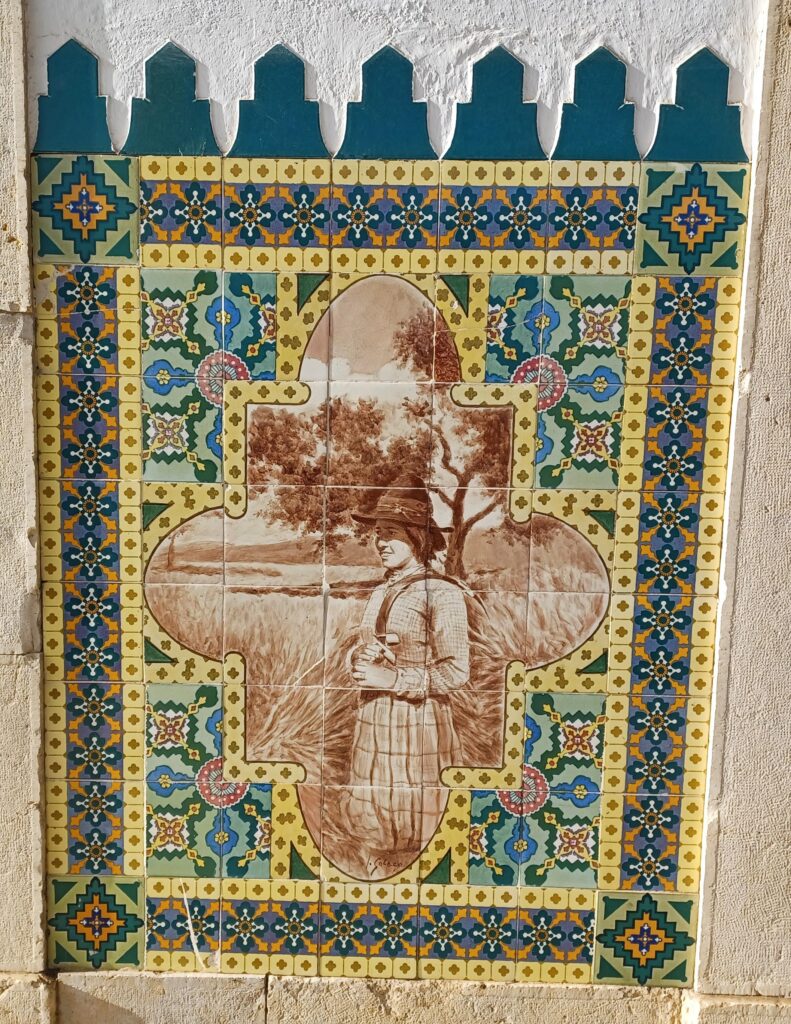
Daytrips
Beja itself is likely a daytrip for many visitors. While you can do the main sites in a day, staying overnight gives you a real feel for the city.
Évora
Évora is about 1 hour 15 minutes by train or a little over an hour by bus. Driving takes a little over an hour. I’ve written a complete foodie travel guide to Évora, including all the amazing Convent Sweets the city has to offer. See the videos about Évora on my YouTube channel.

Lisbon
Lisbon isn’t a daytrip, spend several days there. But, it’s within easy reach of Beja. The bus and train each take about 3 hours, but the bus is far more convenient as there is a connection on the train in Casa Branca with inconvenient or tight connecting times. Driving takes about 2 hours. I’ve written a complete foodie travel guide to Lisbon. There’s also a bunch of Lisbon videos on my YouTube channel.

The Algarve
Depending on where you’re going in The Algarve, the bus takes 2.5 to 3 hours. The train is a nightmare, sending you back near Lisbon before heading back south on a series of connections. Don’t both with the train. Driving takes 90 minutes, plus or minus. I’ve written a complete foodie travel guide to Loulé in The Algarve. I’ve also made videos in The Algarve.

Cuba
No, not the island nation, but a small town a few minutes from Beja by train or car. There is a strong wine making culture with several wineries on the outskirts of town. If you don’t have a car to reach them, visit Adega do Canena and taste their wine aged in authentic clay amphoras.

Transportation
There is no commercial airport in Beja (BYJ airport handles freight and some charter flights), but getting to Beja is pretty easy. There is bus service from Lisbon, The Algarve, and nearby Évora as well as connections from the rest of Portugal. There’s a train station as well that’s good for nearby towns like Évora, though getting to further locations like Lisbon require inconvenient or tight connections; the bus is better.
Even if you take the bus, the train station is worth a visit for the amazing Azulejo Tile Murals.
Local Transportation
Beja is a compact town so it’s easy to get almost anywhere by foot. Be aware that sometimes sidewalks disappear, leaving you walking in the street. Also, there are some gentle hills (nothing like Lisbon!). The sidewalks are typical Portuguese calçada (small cobblestones) and can be slick when wet as well as being uneven. Leave your heels at home!
Biking might seem like a good idea, but I personally don’t like to ride a bicycle in Portuguese cities. The terrain is too rough and hilly. Plus, Portuguese drivers make me nervous. If you want to bike there are 2 wheelers for rent from a couple companies.
Uber and taxis are widely available, though Uber is more expensive than other places in Portual.
Driving in Alentejo (the district where Beja is located) is a good way to see more of this large area with lots of seemingly inaccessible rural towns. However, if you drive to Beja, do yourself a favor and park at your hotel (if they have parking) or at one of the lots on the outside of town. Driving on Beja’s narrow streets isn’t easy and you’ll probably be able to walk to your destination just as fast while not having to worry about parking.
Index of Places to Eat & Drink in Beja
Dona Tengarrinha
Terrific vegan restaurant.
R. dos Infantes 17A, 7800-495 Beja, Portugal
Luiz da Rocha
Going strong for over 130 years! The place to get Porca de Beja (Porcinho Doce) cake.
R. Cap. João Francisco de Sousa 63, 7800-475 Beja, Portugal
Pastelaria Bambina
Wonderful characteristic bakery.
R. de Mértola 65A, 7800-475 Beja, Portugal
Casa de Cha
Bakery with extensive tea selection.
Terreiro dos Valentes 7, 7800-523 Beja, Portugal
Pastelaria Santo Andre
Charming bakery on the outskirts of town.
R. de Santo Andre, 7800-296 Beja, Portugal
Os Infantes
Amazing bar and restaurant in a 16th century (or perhaps earlier) building.
R. dos Infantes 16, 7800-495 Beja, Portugal
Dom Dinis
Very good restaurant near the castle with Espargos com Ovos (Asparagus and Eggs)
Indian Haveli Restaurant
Nice Indian restaurant. Many veg. options.
C Com Carmo, R. de Angola 0 SN Loja 1, 7800-468 Beja, Portugal
Sabores do Campo
Vegetarian buffet restaurant.
R. Prof. Bento de Jesus Caraca n°4, 7800-511 Beja, Portugal
Restaurante Adega Típica 25 de Abril
Classic Alentejo fare.
R. da Moeda 23, 7800-464 Beja, Portugal
Pinguinhas
Known for small Portuguese plates called Petisco.
Praça da Republica 35, 7800-192 Beja, Portugal
Porta 15
Cocktail bar.
R. do Sembrano n.º 15, 7800-487 Beja, Portugal
Index of Things to do in Beja
Beja Castle
Beautifully restored castle. Climb the tower for great views.
Jardim da Rua de Dom Dinis e da Rua de Antero de Quental, R. Dom Dinis 3, 7800-000 Beja, Portugal
Museu Jorge Vieira – Casa das Artes
Museum in the castle dedicated to the surrealist sculptor.
Largo Dr. Lima Faleiro 1, 7800-266 Beja, Portugal
Beja Cathedral
Excellent Azulejo tiles inside.
Chapel of Our Lady of Mercy (Capela de Nossa Senhora da Piedade)
Ornately decorated small chapel with a secret passageway.
R. Dom Manuel I nº 21, 7800-306 Beja, Portugal
Nucleo Museologico
Small Roman era archaeological museum.
Rua do Sembrano, Largo de São João, 7800-487 Beja, Portugal
Visigoth Nucleus
Largest Visigoth museum in Portugal.
Largo de Santo Amaro 26 27, 7800-274 Beja, Portugal
Beja Regional Museum / Queen Leonor Museum
As of this writing, museum is close for renovations.
Largo da Conceicao 5, 7800-131 Beja, Portugal
Index of Shopping in Beja
Market
Saturday morning market with lots of local farmers.
Largo de Santo Amaro 20-22, 7800-266 Beja, Portugal
Herdade dos Grous
Winery and 5 star hotel.
Herdade dos Grous, 7800-601 Albernoa, Portugal
Herdade da Mingorra
One of the oldest wineries in the area.
37.892181, -7, 922933, Portugal
Herdade do Vau
Winery and 3 star hotel.
Lugar Monte do Vau, 7800-661, Portugal
Places to Stay in Beja
Guest House Stories
Excellent budget option.
R. Dr. Afonso Costa 28, 7800-464 Beja
Maria’s Guesthouse
Centrally located, good price.
R. da Misericórdia 18, 7800-285 Beja
About the Author

Brent Petersen is the Editor-in-Chief of Destination Eat Drink. He currently resides in Setubal, Portugal. Brent has written the novel “Truffle Hunt” (Eckhartz Press) and the short story collection “That Bird.” He’s also written dozens of foodie travel guides to cities around the world on Destination Eat Drink, including in-depth eating and drinking guides in Portugal for Lisbon, Porto, Sintra, Évora, Braga, Loulé, Almada, Monsaraz, and Batalha. Brent’s podcast, also called Destination Eat Drink, is available on all major podcasting platforms.
